This post contains affiliate links. Please read my disclosures.
This homemade All-Butter Gluten-Free Pastry Recipe is so easy to work with and incredibly versatile. We use three alternative flours to achieve the perfect crisp texture and incredible buttery taste. It’s delicious as a crust for fruit pies, tarts and mince pies or for savoury quiches. Plus there is no xanthan gum in this recipe so everyone can enjoy it.
Jump to:
- Why you'll love this gluten-free pastry
- Ingredients needed
- Shop the recipe
- Flour substitutions
- How do you make gluten-free pastry?
- Pro Baking Tips
- How much pastry does this make?
- How can you use this gluten-free pastry?
- More gluten-free recipes you'll love
- The Best All-Butter Gluten-Free Pastry (no xanthan gum)
One of my most frequently asked questions is ‘How do you make the perfect gluten-free pastry?’
Let me tell you, gluten-free pastry is so much easier to make than you think. It can seem intimidating as it’s confusing knowing which brand of flour is best and whether we should add xanthan gum or not.
Well actually there is a better way. We use three particular alternative flours so you can make this pastry whatever country you are baking in as it is not brand dependent. Plus there is no xanthan gum in this recipe so if you are intolerant or don’t like using it then rest assured - you simply don’t need it here.
Despite the minutiae of detail I’ve given you below making gluten-free pastry is actually pretty simple. I can’t wait to ignite your love for gluten-free pie baking and give you bags of confidence in making any pastry recipe you like.
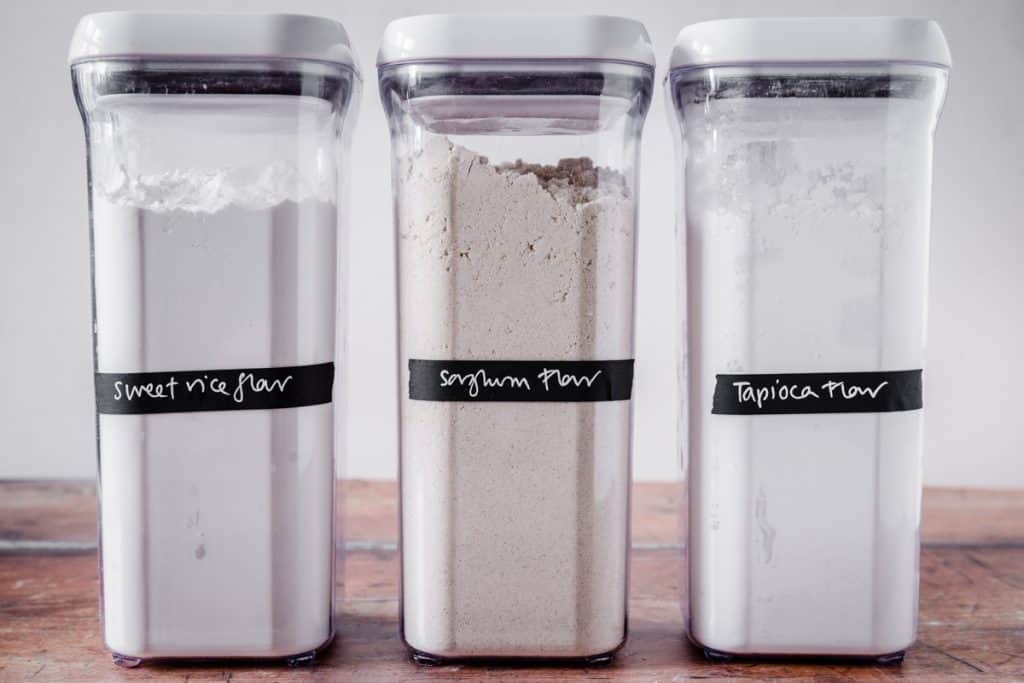
Why you'll love this gluten-free pastry
- There is no complicated technique.
- Only 3 alternative flours are used.
- No xanthan gum!! Read More >>> Why I never bake with xanthan gum – this ingredient is not my favourite.
- Easy to roll out with no cracking.
- Gorgeously buttery taste. The pie crust alone is a treat before you’ve even filled it!
- Beautifully crisp texture.
- So versatile - can be used for sweet or savoury recipes.
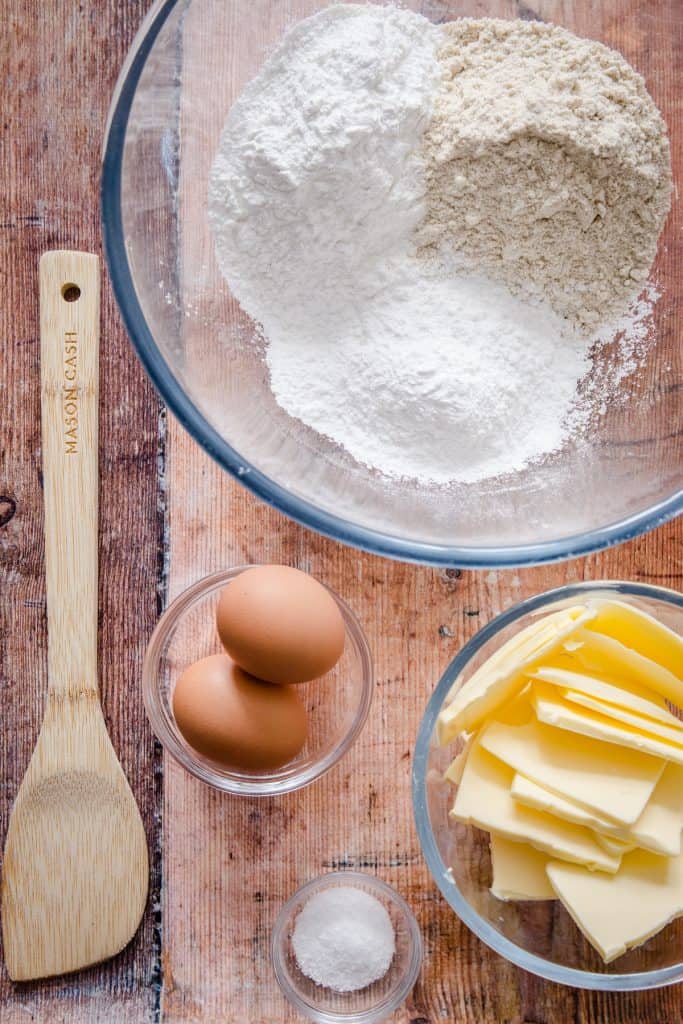
Ingredients needed
- Sweet rice flour – this is the important flour to use. It gives the pastry excellent structure. It’s unique binding properties give the pastry elasticity so it’s easy and forgiving to roll. Also it’s quite neutral in taste so will go with everything.
- Sorghum flour – adds a crisp bite to the pastry and a lovely earthy flavour.
- Tapioca flour – a smooth soft flour which also helps bind the ingredients but also gives a lovely golden colour and crust when baked.
- Butter – this is how we achieve our beautifully buttery flavour.
- Eggs – we use a whole egg for a rich taste then an extra egg white on top helps to avoid a crumbly pastry.
- Salt – just a pinch.
Shop the recipe
 Buy Now →
Buy Now →  Buy Now →
Buy Now →  Buy Now →
Buy Now → Flour substitutions
The sweet rice flour and the tapioca flour are non-negotiable flours here I’m afraid – they provide very unique roles in the texture and colour of the pastry. The sorghum flour is a great all-rounder and makes the perfect triumvirate but it can be substituted.
My favourite substitutions for the sorghum flour are the following:
Buckwheat flour – lovely with fruit pies or quiche.
Chestnut flour – perfect for seasonal baking like mince pies and complimentary with rich flavours like this stilton tart.
How do you make gluten-free pastry?
If you have made pastry before then you will find this recipe a cinch. There is no complicated technique, lengthy resting time or expensive equipment. Just a mixing bowl, a balloon whisk, baking parchment, rolling pin and your hands.
- Whisk together the sweet rice flour, sorghum flour, tapioca flour and salt.

- Slice the cold butter directly from the fridge and rub into the pastry until the texture is quite shaggy.


- Make a well and pour in the whisked egg + egg white.

- Bring the dough together in the bowl then tip it out onto a floured surface and knead for a minute or so until the dough becomes a cohesive smooth ball.



- Wrap in baking parchment and rest for an hour in the fridge.

- Roll the pastry out between two sheets of floured baking parchment to the size required.



- What you do next with the pastry will depend on what you are making.
Pro Baking Tips
Now that you know the loose method let’s get into the nitty gritty details to ensure your pastry is perfect every time.
Butter
- Keep the butter cold. Take it out of the fridge just before you slice it and place it into the flour. Tuck each slice of butter into the flour one at a time rather than dumping it in all at once. Cold butter means that as it melts during the bake which means a tender pastry. Warm butter means greasy tough pastry.
- You don’t want to turn the butter and flour into breadcrumbs. The butter should have some larger pieces and a rough craggy texture.
Eggs
You will need an extra egg white for this recipe but save the egg yolk. It’s perfect to use for either sealing the pastry during the blind bake if that’s what your recipe requires or for an egg wash on the pastry crust.
Bringing the dough together
When you have added the eggs, start bringing the dough together with floured hands. Once it more or less holds together in a very shaggy ball, then tip out onto a floured surface and gently knead together for a good couple of minutes. The gluten-free flours will absorb the liquid from the egg, and it will start to become smooth, not sticky or crumbly. Once you can roll it between your palms into a nice smooth ball then wrap in parchment paper.
Resting
The pastry needs to rest in the fridge for at least 1 hour before rolling out so the flours can relax into each other and absorb the liquid which makes it a stronger pastry. Plus the butter needs to chill.
Flouring
Use tapioca flour for flouring the surface, your hands and for rolling out the pastry. I recommend a flour shaker so that it dusts the worktop lightly and evenly.
Rolling
- After the chill the best tip is to roll the pastry out between two sheets of lightly floured baking parchment. It makes rolling the pastry out so much easier, it doesn’t stick to the rolling pin and means no fuss in transferring the pastry to a pie dish.
- Use a long wooden rolling pin.
- If you need to roll your pastry into a round then turn the baking parchment round a quarter after every roll.
- Roll the rolling pin in deft smooth movements from the centre out to ensure a nice even pastry surface.
- The pastry should be about 5mm thickness (too thin and the pastry will be difficult to handle).
- When your pastry is the right size, use your rolling pin to help lift it over the pie tin if that’s what you’re making.
- If you’re making small individual tarts then this is the point where you use your pastry cutter to achieve the right sizes.
Patch that pastry
Cracking can happen when you go to transfer your pastry wherever it needs to go, especially if you are a nervous first timer and aren’t working quite as deftly. Don’t fret at all – gluten-free pastry is more fragile. Just patch up the breaks or cracks with the excess pastry. No one will be any the wiser.
Second chill
Once you have rolled the pastry and placed it in your pie or tart tin then chill it a second time for 30 minutes before the bake. This will mean your butter gets cold again and your pastry will be crisp but tender.
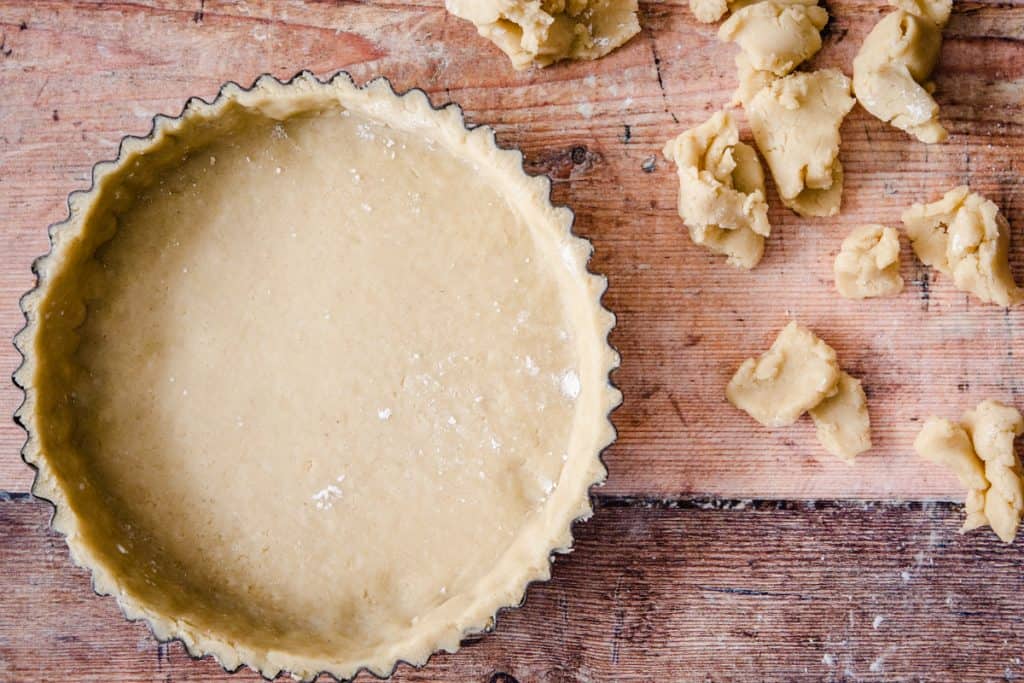
How much pastry does this make?
This amount of pastry that this recipe makes is enough for an 8 inch double crust pie. Or for 12 mini tarts made in a regular sized muffin tin.
However, I do not halve the recipe if I’m just making a single crust as it’s easier to make if sticking to these quantities.
If you have leftover pastry then you can freeze it or keep it in the fridge for up to 3 days. However, I like to use it to make jam tarts.
How can you use this gluten-free pastry?
- As a crust for fruit pies, tarts or savoury quiches
- Mince pies
- Jam Tarts
More gluten-free recipes you'll love
If you make this Gluten-Free Pastry then please leave a comment below and give the recipe a rating which helps others find it on Google. If you then go on to use this recipe as a launch pad for your own baking creation then I’d also love it if you’d share it and tag me on Instagram. It is so lovely for me to see your versions and variations of my recipes.
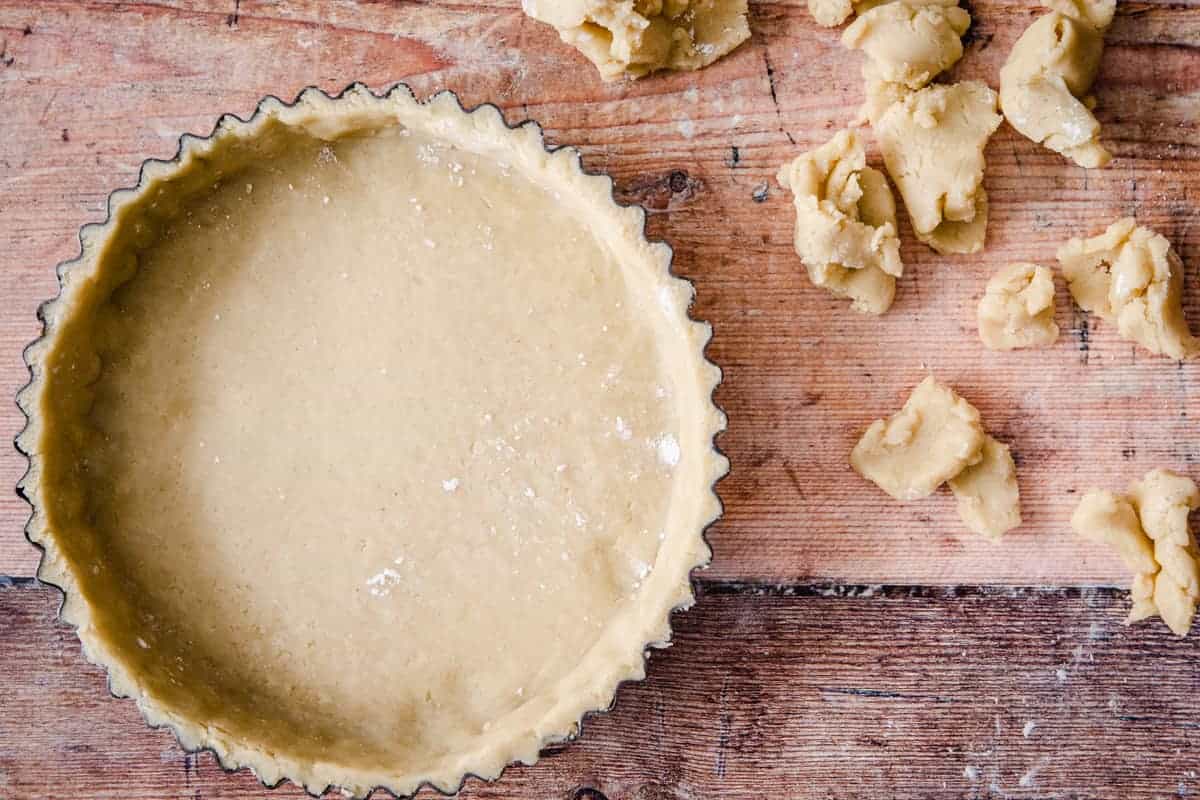
The Best All-Butter Gluten-Free Pastry (no xanthan gum)
Ingredients
- 120 g sweet rice flour - glutinous rice flour
- 110 g sorghum flour
- 60 g tapioca flour
- ½ teaspoon sea salt
- 200 g unsalted butter - cold from the fridge
- 1 egg + 1 egg white - medium sized, lightly whisked together
Instructions
- In a large mixing bowl whisk together the sweet rice flour, sorghum flour, tapioca flour and salt.
- Slice the butter very thinly directly from the fridge and add to the flour.
- Rub the mixture between fingertips until roughly shorn. The mixture does not need to resemble breadcrumbs. It’s okay that the butter is still in largish pieces. It should look quite shaggy in the flour.
- Make a well in the centre and pour in the eggs.
- Bring the dough together using your hands.
- Turn the pastry out on to a floured work surface and knead for about two minutes until the dough comes together into a smooth ball which is no longer sticky.
- Cut the pastry into two, one half slightly larger than the other.
- Roll each half into balls and flatten slightly to make two thick round discs. Wrap each in baking parchment.
- Place in the fridge for 1 hour to chill before rolling out.
- Cut two large pieces of baking parchment, around the size you need to roll the pastry out to. Flour them on the inside and place one of your chilled pastry discs between the parchment.
- Using a long rolling pin roll out the pastry until it is about 5mm thick.
- The pastry is then ready to use.
Video
Notes
- Butter - Keep the butter cold and use it directly from the fridge.
- Rubbing the butter and flour – you want to end up with the butter in largish pieces and a rough craggy texture.
- Eggs - You will need an extra egg white for this recipe but save the egg yolk. It’s perfect to use for either sealing the pastry during the blind bake if that’s what your recipe requires or for an egg wash on the pastry crust.
- Flouring - Use tapioca flour for flouring the surface, your hands and for rolling out the pastry. I recommend a flour shaker so that it dusts the worktop lightly and evenly.
- Rolling - After the chill the best tip is to roll the pastry out between two sheets of lightly floured baking parchment. It makes rolling the pastry out so much easier, it doesn’t stick to the rolling pin and means no fuss in transferring the pastry to a pie dish.
- Don’t worry if you pastry breaks when you transfer it, gluten-free pastry is more fragile. You can patch it up with your pastry scraps.
- Once you have rolled the pastry and placed it in your pie or tart tin then chill it a second time for 30 minutes before the bake. This will mean your butter gets cold again and your pastry will be beautifully flaky.
Ingredient measurements
- Please note when you see ‘grams’ listed as opposed to ‘millilitres,’ or any other term of measurement, that is not incorrect. I weigh all of my ingredients, including liquids, for accuracy.
- US customary measurements for the ingredients provided are based on a conversion calculator. This recipe was tested with metric measurements and I recommend using a digital scale to weigh ingredients for the most accurate results. READ MORE >>> Why you should always weigh vs measuring with cups

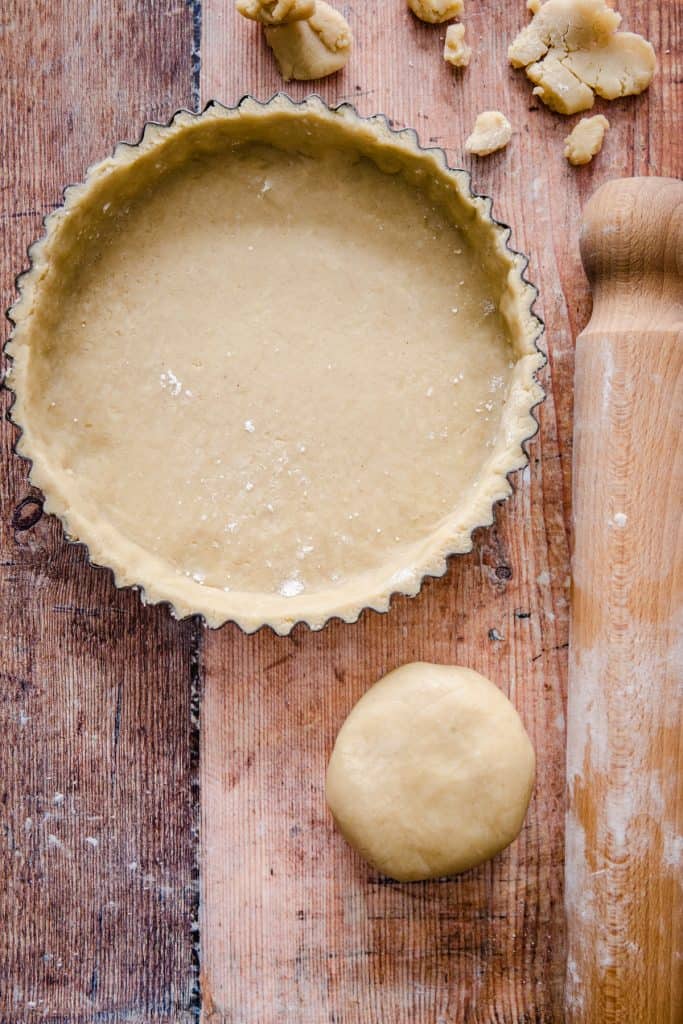
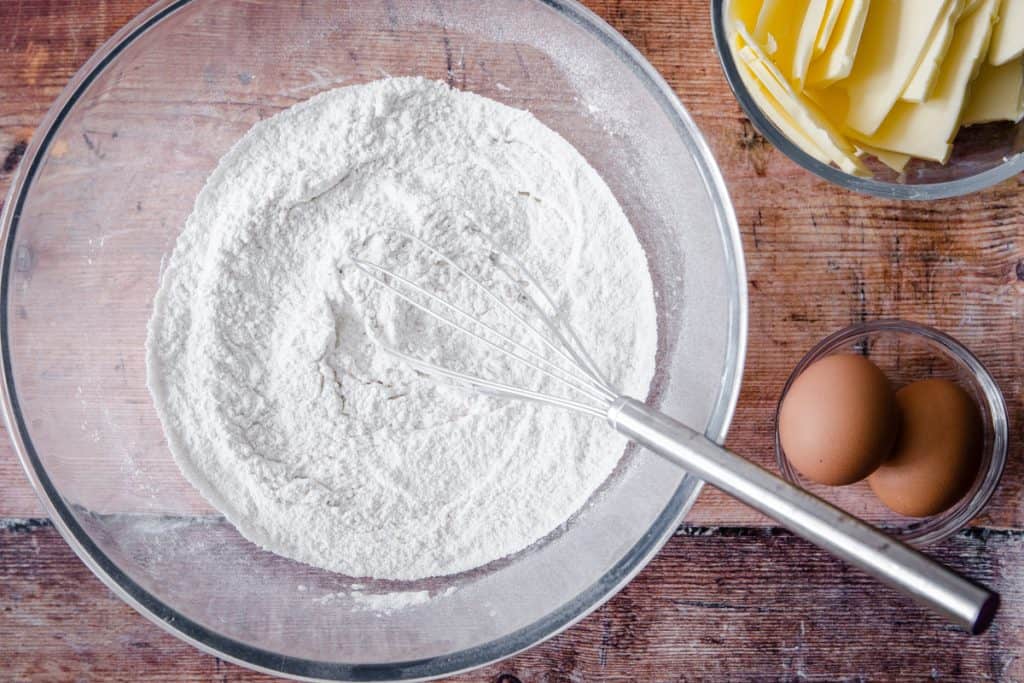
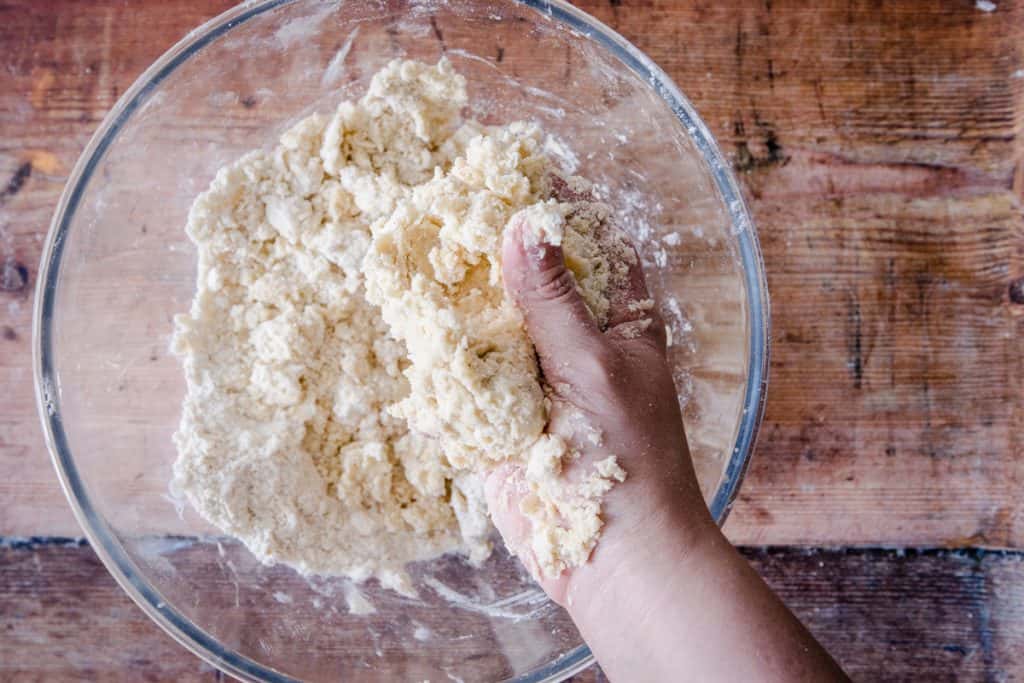
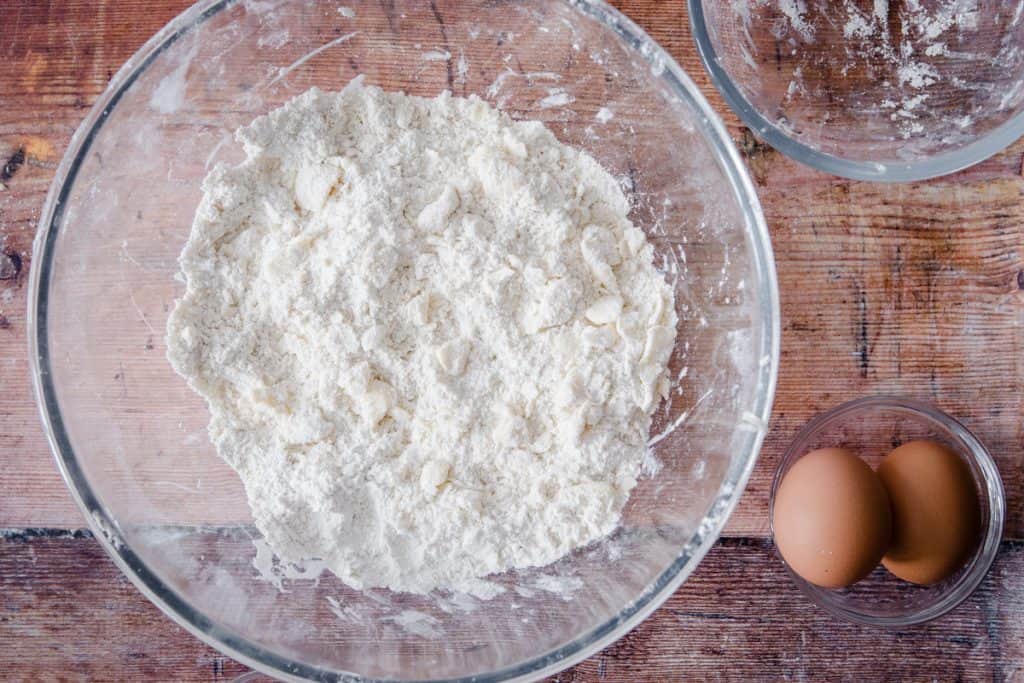
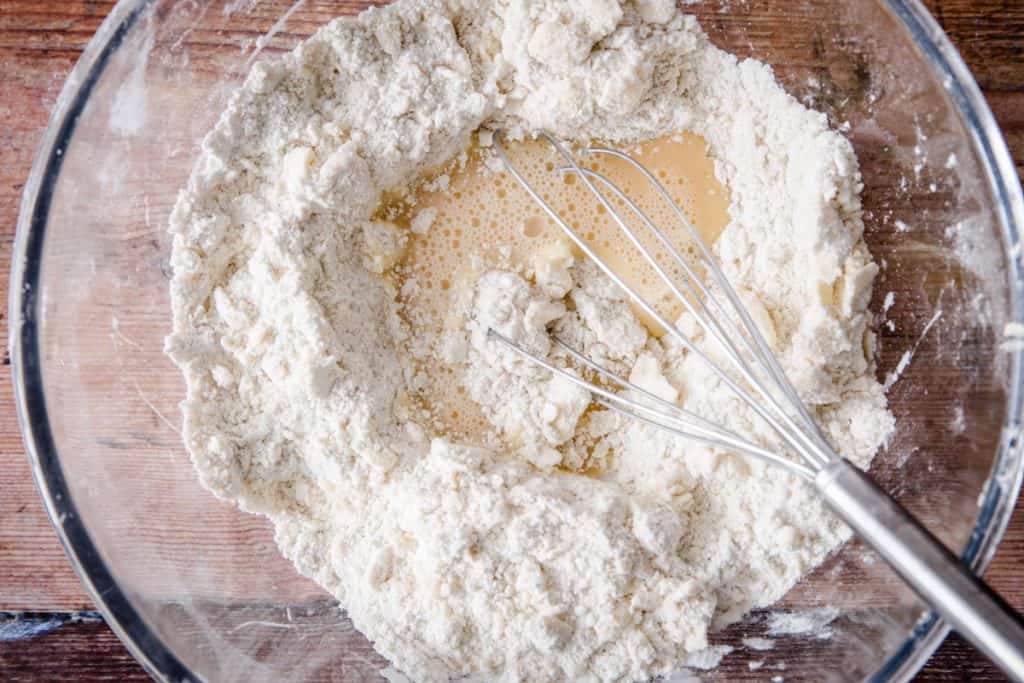
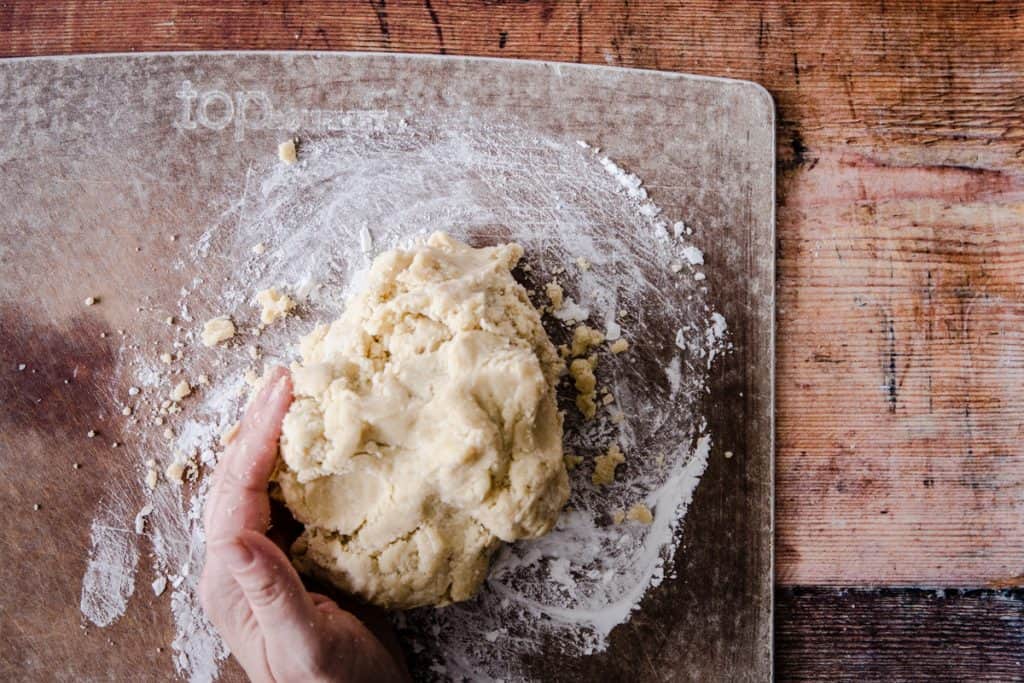
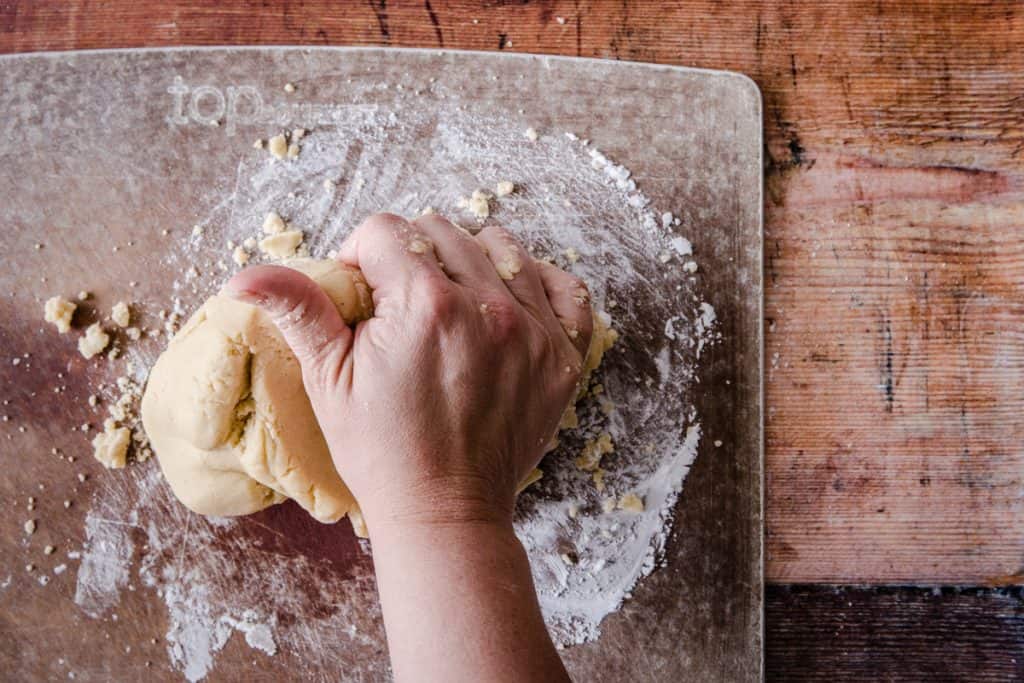
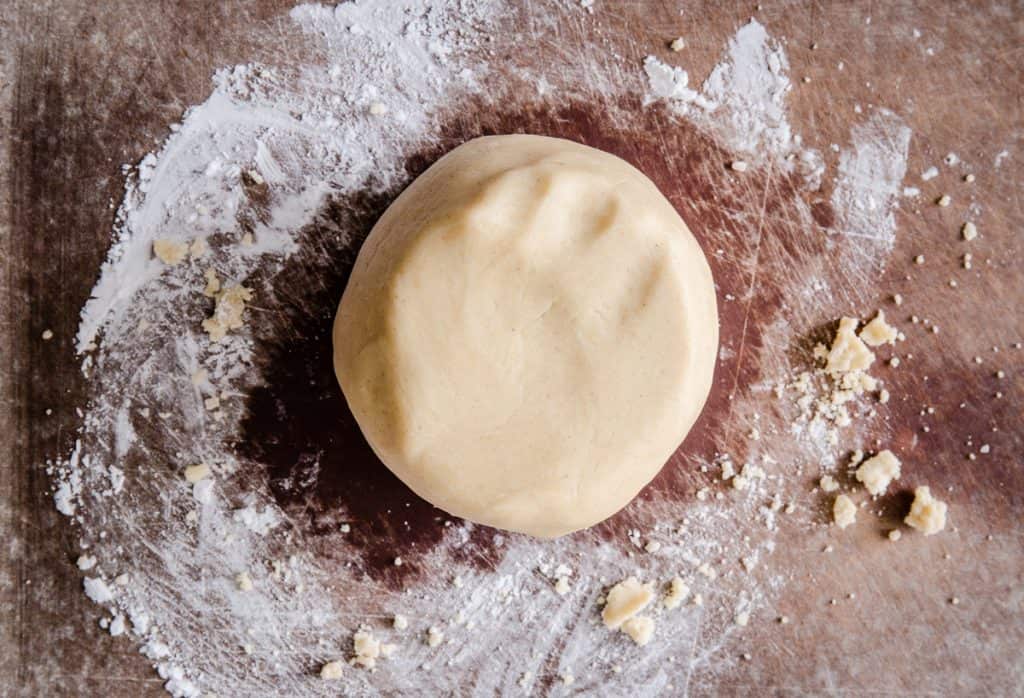
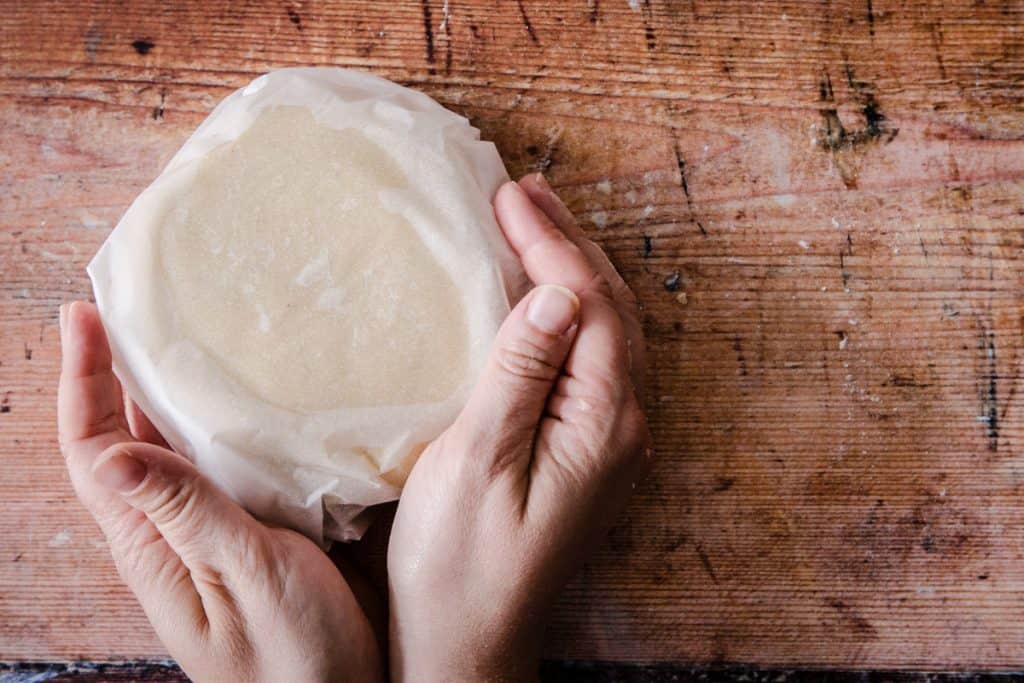
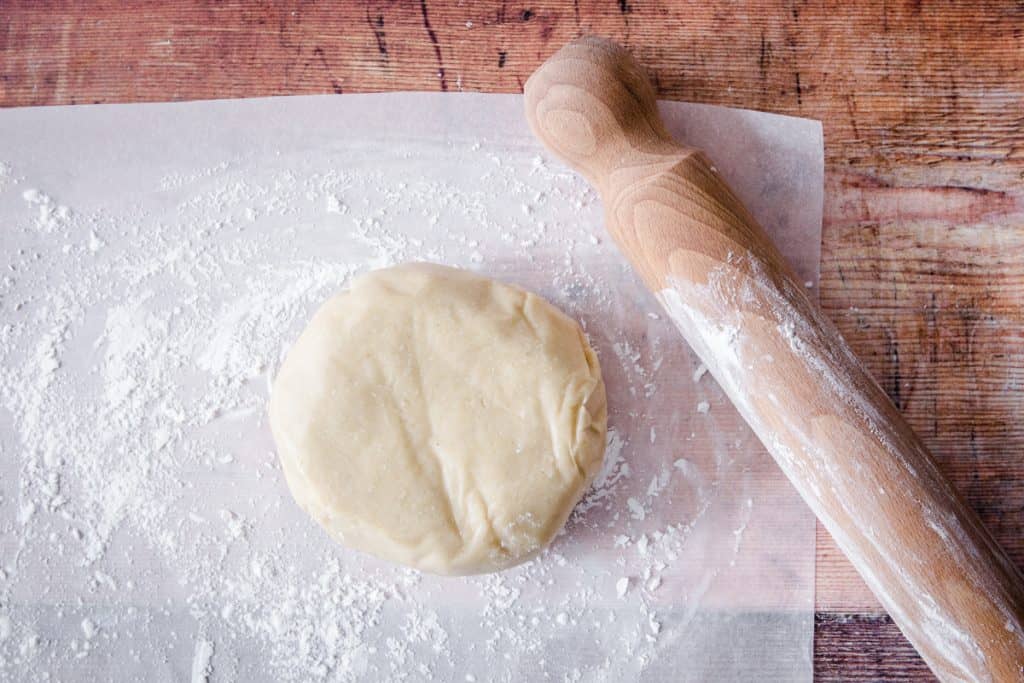

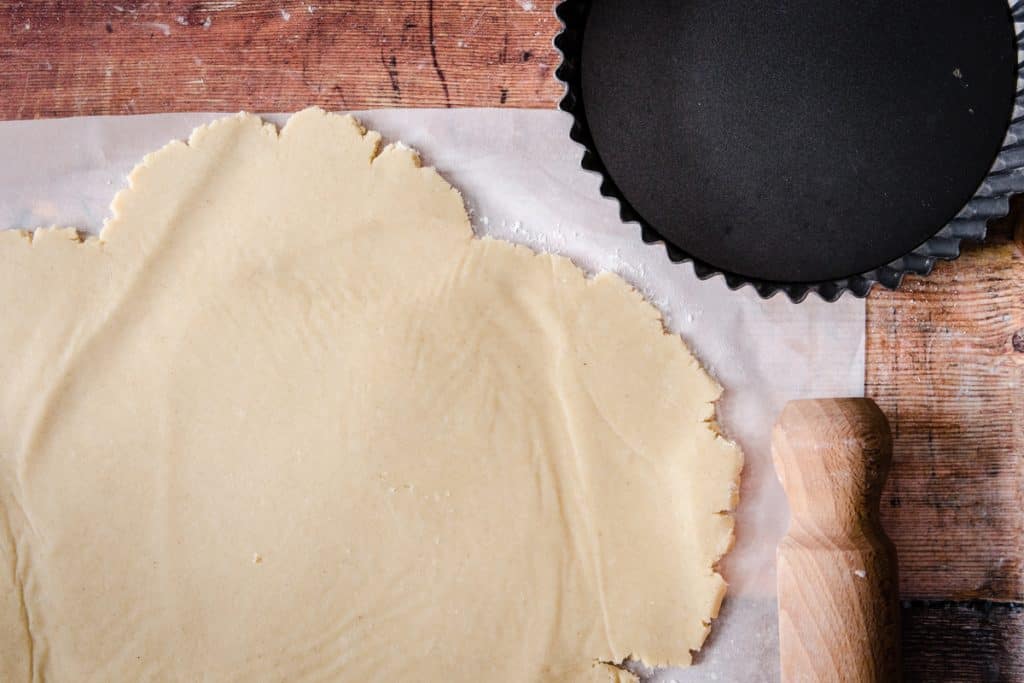

ET says
You don't say what temperature to bake the GF pastry at... ?
Am cooking a meat pie. Making it up as I go along... wish me luck!
Georgina Hartley says
It depends on what you are using the pastry for as to the temperature you bake it at. For a meat pie this temperature is pretty standard: 180°C / 160°C fan assisted / gas mark 4 / 350°F. Let me know how it goes!
Doris says
Hi , Can I substitute sweet rice flour ? In my country I cannot find where to buy it. Instead of sorghum flour I am going to use buckwheat flour, what goes with it to give me the same result.? Thanks
Doris
Georgina Hartley says
You can substitute it for defatted almond flour. You could try subbing it for cassava flour too.
Tracy Capeling says
Delicious pastry! So mouthwatering! I made my mom’s apple pie recipe with this pastry today. I am so thankful for your recipes! I’m really addicted to them and I really appreciate the effort you have put into crafting these delicious treats . Hello and kudos from Tracy and Canada. All the best to you and your family.
Georgina Hartley says
I'm so happy you could use it for such a special recipe! Thank you for letting me know how you got on with it.
Elisabeth Elmquist says
Well I have obviously lost any pastry skills I had! The whole thing just crumbled and broke. I did manage to get it into the baking form with a lot of patching and bake for the 25minutes. When I brushed on the egg wash it disintegrated even more. I put the remaining half of the dough in the freezer, so wonder now how this will turn out when I come to use it. So now an upside down quiche with the pastry crumbs sprinkled on top!! 🙂 🙂
Sherry says
I used this pastry recipe with the exact ingredients in a chicken pie and it was wonderful! I'm so glad I found it! I did use my food processor to mix the ingredients as my fingers and wrist are arthritic. Once I turned it out on a floured work surface it was easy to knead the ball of dough. I need more practice rolling out the dough so a beef pie will be next! Thank you so much!
Georgina Hartley says
You are so welcome - I'm happy you enjoyed the pastry recipe!
Kate Hybert says
Excellent recipe. I used buckwheat flour instead of sorghum. And grated my butter into the flour which made it much easier to rub together. I panicked a bit when I needed to bring the dough to a ball as it seemed too dry. But I persisted and it worked out fine. Good tip about using two sheets of parchment.
All in all a great result. Thank you.
Georgina Hartley says
I'm so happy to hear you had great success with the pastry! Thank you for sharing your feedback!
Mary says
Can I use this recipe for Potpies crusts?
TRULY LOVE YOUR SITE
Forever in your debt,
Mary
Western Canada
Georgina Hartley says
Hi Mary, yes it can!
Susan says
Can I substitute cold coconut oil for the butter or is there something better? My son can't tolerate milk products or gluten. Thank you. I sent this under your gluten free flour blend by accident lol.
Georgina Hartley says
I'm afraid I haven't tried the recipe with a butter alternative so I can't advise you in good conscience.
Kim says
I tried this with a non-dairy margarine. Being very careful to keep it cold (and I suspect with coconut oil it would be very difficult to work it with your fingers without it melting)... But I did get a great result.
Georgina Hartley says
I'm so happy to hear that - it's great to know it works well!